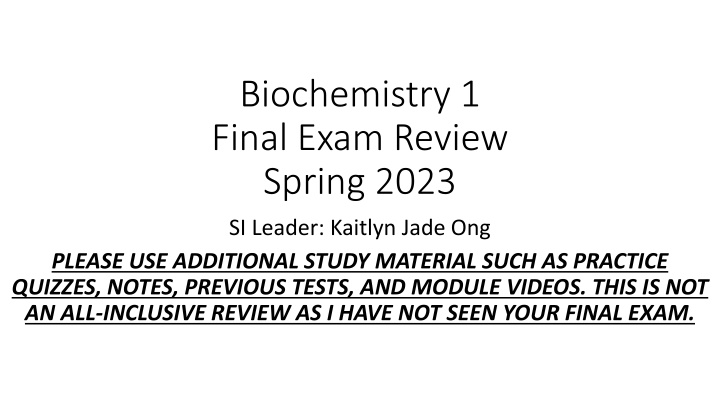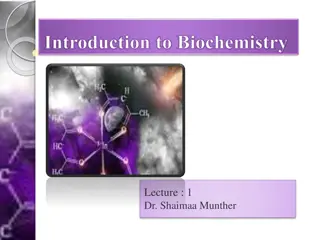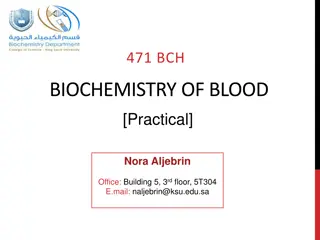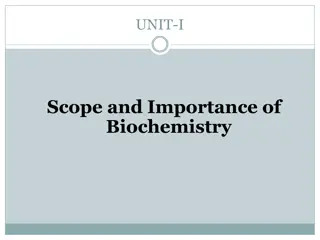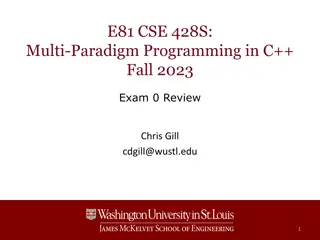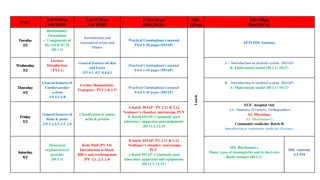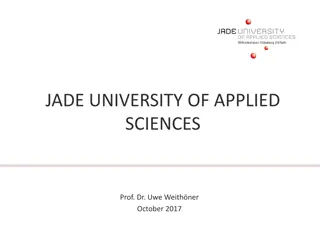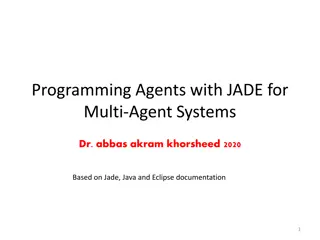Biochemistry 1 Final Exam Review Spring 2023 SI Leader: Kaitlyn Jade Ong
Review materials for the Biochemistry 1 final exam include topics on membrane transport, lipid structures, melting points of fatty acids, calcium transport mechanisms, Na⁺-K⁺-ATPase classification, adenylate cyclase signaling pathway regulation, and Ras signaling pathway proteins inactivation.
Download Presentation

Please find below an Image/Link to download the presentation.
The content on the website is provided AS IS for your information and personal use only. It may not be sold, licensed, or shared on other websites without obtaining consent from the author.If you encounter any issues during the download, it is possible that the publisher has removed the file from their server.
You are allowed to download the files provided on this website for personal or commercial use, subject to the condition that they are used lawfully. All files are the property of their respective owners.
The content on the website is provided AS IS for your information and personal use only. It may not be sold, licensed, or shared on other websites without obtaining consent from the author.
E N D
Presentation Transcript
Biochemistry 1 Final Exam Review Spring 2023 SI Leader: Kaitlyn Jade Ong PLEASE USE ADDITIONAL STUDY MATERIAL SUCH AS PRACTICE QUIZZES, NOTES, PREVIOUS TESTS, AND MODULE VIDEOS. THIS IS NOT AN ALL-INCLUSIVE REVIEW AS I HAVE NOT SEEN YOUR FINAL EXAM.
Indicate whether the following compounds are likely to cross a membrane by non- mediated or mediated transport: (a) cholesterol (b) 1 molecule of ATP. 2
Rank the melting points of the following fatty acids from highest to lowest: A. 1 > 2 > 3 > 4 B. 4 > 2 > 1 > 3 C. 4 > 3 > 2 > 1 D. 4 > 1 > 2 > 3
In the structure of the following lipid, a) circle hydrophilic head and hydrophobic tail; b) Indicate the atoms of the functional groups in the head that will form hydrogen bonds with water.
Ca++ is being transported out of a cell. The [Ca++] inside is 10-7 M and the [Ca++] outside is 10-3 M. At 37 , is this a spontaneous mechanism? The membrane potential is -60 mV (inside region is negative). F is 96495 C/mol 6
How the Na+-K+-ATPase can be classified? A) a symport. B) a uniport . C) an antiport. D) none of the above. 7
Which of the following is/are mechanisms used to turn off the adenylate cyclase signaling pathway? Select all that apply A. Inherent GTPase activity of Gi . B. Inhibition of cAMP phosphodiesterase. C. Binding of hormones to Gi- linked receptors. 8
List three proteins that participate in the kinase cascade of the Ras signaling pathway and indicate the mechanisms of their inactivation. 9
Cholera toxin is able to penetrate intestinal cells and block GTPase activity of Gs . Is the level of cAMP increased or decreased in toxin-affected intestinal cells? 10
You need to determine the primary structure of a peptide X. You perform fragmentation of the peptide using two different fragmentation methods (A and B). The sequences of the obtained cleavage fragments are below. Deduce the primary structure of the peptide X. Method A 1) VNYM 2) VMFR 3) AWGK 4) AYMIQR Method B 1) M 2) AW 3) RAY 4) GKVMF 5) MIQRVNY
Involves GPCR (with heterotrimeric G protein Gq) Phosphoinositide Pathway Phosphatidylinositol- 4,5-bisphosphate What class of lipid does PIP2 belong to? glycerophospholipids Is IP3-gated Ca2+ channel an active or passive transporter? [Ca2+] changes from 0.1 M to 10 mM passive 12 12
List three second messengers that participate in the phosphoinositide signaling pathway and indicate the mechanisms of their inactivation. IP3, DAG, and Ca2+ are second messengers in the phosphoinositide pathway. IP3 is hydrolyzed by inositol polyphosphate 5-phosphatase; Ca2+ is pumped from the cytosol back to the ER by Ca2+-ATPase. DAG and IP3 recombine to form PIP2. 13
Good luck! You got this! (Please continue studying with other material too) 14
